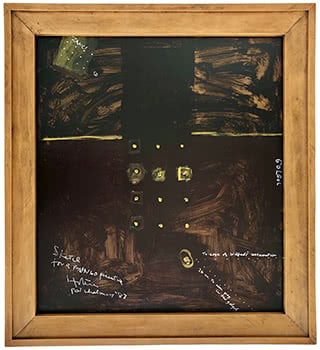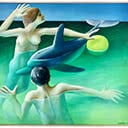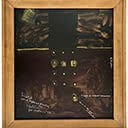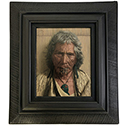Mungo
77.5 x 69.5 cm
est. $35,000 - 45,000
PROVENANCE
Private Collection, Auckland
Mungo Painting marks the beginning of the artist's Mungo series, inspired by his time spent in New South Wales. The Mungo series addresses the link between social and environmental issues in both New Zealand and Australia and offers a meditation on the length of human existence. The work expresses sentiments of spirituality and humankind's connection to the land, together, these have been a recurring presence at the heart of Hotere's practice.
Compositionally, Hotere has adapted the format of the archaeologist's location diagram, showing the positioning of 12 samples within the central portion of the work, and one offset temperature monitor, which sits slightly apart from the central formation. The words Mungo, Gol Gol and Zanci are Aboriginal terms for the different layers of sand in which the human remains were found. Gol Gol is the reddish base layer of sand, Mungo the middle brown sand and Zanci the windborne grey dust and gypsum. The reference to these various layers is enhanced in the work by Hotere's use of understated earthy tones. All of the work's components rest comfortably in the subtle crucifix formation: a frequent motif used by Hotere throughout his work.
Previous to Mungo series, Hotere had thoroughly developed his distinctive window motif. Specifically framing his works in custom timber frames, Hotere replicated the view from his studio at Aramoana where he observed the injustice imposed on the land and the people.
While the previous series of the early 1980s dealt specifically with contemporary issues such as the development of the aluminium smelter at Aramoana and the controversial Springbok Tour, the Mungo series presents a deeper contemplation about time and the binary effects of humans on the land and eventually of the land on human remains. This wider observation about the circle of life culminated with Hotere's production of the large-scale installation work titled Black Phoenix, Collection of Te Papa Tongarewa, which he constructed from the burnt- out hull and charred debris of a Carey's Bay fishing boat. The symbolism of the mythical Phoenix rising from the ashes to begin a new circle of life, resonates with the necessary acceptance of our own mortality, something which Hotere himself would have been unavoidably confronted with during his time spent at Lake Mungo.





